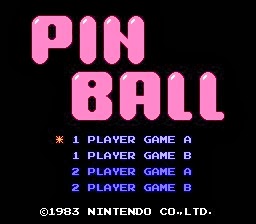 |
| Developer: Nintendo Publisher: Nintendo Released: 1985 |
In 1985, pinball was still a pretty popular pastime. The machines stood in the arcades next to Pac-Man and Dig-Dug, but their time in the sun was about to fade. The video game boom almost ended up being the death of pinball. Why play a pinball game where only a few things can happen when you can play a video game where anything can happen? For that matter, why offer a pinball game in your arcade when you can offer a video game that breaks less and still rakes in the same amount of cash?
Oddly enough, though, instead of killing pinball, video games helped save it. We'd all love to have space in our house (and the disposable income) for a Doctor Who pinball machine, but we can't. The making of new pinball machines has almost ground to a halt. Arcades are dying, so there aren't any community places for pinball machines.
Yet, people still want to play pinball, and pinball video games filled the void. Early games like Pinball show why.
Pinball wasn't the first pinball video game. There was David's Midnight Magic for the Apple IIe and an unrelated game called Midnight Magic for the Atari 2600. However, what both of those games did was shrink down the board so it could all fit on the screen. They also hewed pretty closely to pinball conventions, with very few video game touches, as seen below:
When making Pinball, Nintendo decided not to shrink down the board, but rather to divide the board into two discrete screens. Players could move in between both screens with careful timing. That was an interesting choice, since it allowed for more detail on each board, which makes Pinball look more like a real pinball game. It also encourages the player to get to the top screen where points are more plentiful, while not penalizing the player as harshly for a missed flipper.
That also helps to improve pinball's interactivity. If pinball has a flaw, it's that the player only has control of the ball for a brief moment and then it's relinquished. By having three discrete screens each with flippers, the player has more time to work with the ball and more chances to make something happen. This is an idea that Nintendo has stuck with in later pinball games.
Nintendo also added ideas from video games into Pinball. Instead of just having the same old flippers and bumpers from normal pinball games, they could add in moving objects, minigames and other things that weren't possible in standalone pinball games.
Pinball purists may object to this idea. For them, pinball machines are kind of like jazz: You know that there are going to be certain things in a pinball machine, but what's exciting is how the pinball machine makers mix up the order and variation of the similar beats. By adding in video game elements, purists may argue, the essence of pinball is lost.
On the one hand I agree with that sentiment. Yet on the other hand, pinball's heyday is gone and it's never coming back. Maybe if players enjoy a pinball video game, they'll seek out the real thing. It could happen.
Either way, Pinball was a push in the right direction for pinball video games and was an excellent choice for a launch game.


































